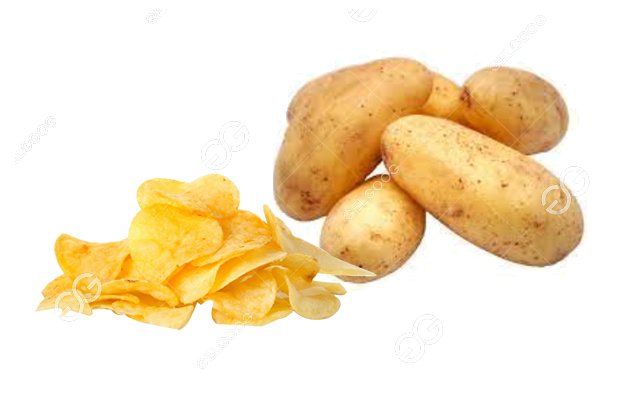How Are Potato Chips Made in Factories?
Oct 27, 2023 | Emily
 164
164
 164
164
Potato chips, those irresistible, crispy snacks, have a fascinating journey from humble potato to crunchy delight. But how are potato chips made in factories? In this article, we'll take a behind-the-scenes look at how potato chips are made in factories.

Potato selection and preparation
The journey of a potato chip begins with the selection of high-quality potatoes. These factories source a variety of potato types, primarily russet or white potatoes, chosen for their low sugar content and high starch content. The potatoes undergo rigorous inspection and cleaning to remove any impurities.
Peeling and slicing
Once the potatoes are cleaned, they move through a series of machines that peel and slice them into the familiar thin, circular shapes. The thickness of the slices can be adjusted according to the desired chip style, whether it's a classic thin chip or a thicker, kettle-cooked variety.
Blanching
The sliced potatoes are then blanched in hot water for a short period, which serves several purposes. It helps remove excess starch, improves the final chip's color, and helps in reducing acrylamide formation during frying, a potentially harmful chemical.
Frying
The most critical step in potato chip production is frying. The potato slices are immersed in hot oil. The exact temperature and duration vary depending on the factory's recipe and the desired texture and taste. The chips float on the surface of the oil, and as the water inside them evaporates, they become crispy and golden brown.
Seasoning
After frying, the chips move to a seasoning drum or conveyor, where they are dusted with a variety of flavorings. This can range from simple salt for the classic potato chip to more exotic and unique seasonings for specialty flavors.
Quality control
Modern factories place a strong emphasis on quality control. Automated systems and human operators continuously monitor factors such as color, flavor, and texture to ensure that every chip meets the highest standards. Any chips that don't meet these standards are discarded.
Packaging
Once the chips are cooked and seasoned to perfection, they are ready for packaging. They are transferred to packaging machines that weigh and portion them into bags or containers. The bags are then sealed to maintain freshness.
Distribution
The final product, now packed and ready for distribution, is shipped to stores and supermarkets all around the world. Modern logistics and distribution systems ensure that consumers can enjoy fresh potato chips in their homes.
The production of potato chips in factories is a marvel of food processing technology. From the careful selection of high-quality potatoes to the precise frying and seasoning processes, the journey from raw spud to delectable snack is a fascinating one. It's a testament to the marriage of traditional craftsmanship and cutting-edge technology that allows us to savor these crispy delights in countless flavors and varieties. If you want to start the potato chips business, and need any potato chips processing machine, leave message to us.

Potato selection and preparation
The journey of a potato chip begins with the selection of high-quality potatoes. These factories source a variety of potato types, primarily russet or white potatoes, chosen for their low sugar content and high starch content. The potatoes undergo rigorous inspection and cleaning to remove any impurities.
Peeling and slicing
Once the potatoes are cleaned, they move through a series of machines that peel and slice them into the familiar thin, circular shapes. The thickness of the slices can be adjusted according to the desired chip style, whether it's a classic thin chip or a thicker, kettle-cooked variety.
Blanching
The sliced potatoes are then blanched in hot water for a short period, which serves several purposes. It helps remove excess starch, improves the final chip's color, and helps in reducing acrylamide formation during frying, a potentially harmful chemical.
Frying
The most critical step in potato chip production is frying. The potato slices are immersed in hot oil. The exact temperature and duration vary depending on the factory's recipe and the desired texture and taste. The chips float on the surface of the oil, and as the water inside them evaporates, they become crispy and golden brown.
Seasoning
After frying, the chips move to a seasoning drum or conveyor, where they are dusted with a variety of flavorings. This can range from simple salt for the classic potato chip to more exotic and unique seasonings for specialty flavors.
Quality control
Modern factories place a strong emphasis on quality control. Automated systems and human operators continuously monitor factors such as color, flavor, and texture to ensure that every chip meets the highest standards. Any chips that don't meet these standards are discarded.
Packaging
Once the chips are cooked and seasoned to perfection, they are ready for packaging. They are transferred to packaging machines that weigh and portion them into bags or containers. The bags are then sealed to maintain freshness.
Distribution
The final product, now packed and ready for distribution, is shipped to stores and supermarkets all around the world. Modern logistics and distribution systems ensure that consumers can enjoy fresh potato chips in their homes.
The production of potato chips in factories is a marvel of food processing technology. From the careful selection of high-quality potatoes to the precise frying and seasoning processes, the journey from raw spud to delectable snack is a fascinating one. It's a testament to the marriage of traditional craftsmanship and cutting-edge technology that allows us to savor these crispy delights in countless flavors and varieties. If you want to start the potato chips business, and need any potato chips processing machine, leave message to us.

 Tel:0086-15515573212
Tel:0086-15515573212  E-mail:sherry@gelgoog.com
E-mail:sherry@gelgoog.com 
